Colombia unveils 'Miranda' rifle, marking break from Israeli arms
Colombia has unveiled its first locally made assault rifle, the "Miranda," symbolizing a move toward defense independence and a political break from Israeli arms amid solidarity with Palestine.
-

Colombia unveiled the new domestically manufactured rifle that President Petro proposed naming "Miranda," in memory of Francisco de Miranda. Credit: (@petrogustavo / X).
Colombia has taken a major step toward defense independence with the unveiling of its first domestically designed and produced assault rifle, named "Miranda." The firearm, developed by the Colombian Military Industry (Indumil), will gradually replace the Israeli-made Galil ACE rifles currently used by the country's armed forces.
President Gustavo Petro presented the new weapon on Thursday as a symbol of Colombia's technological progress and national pride. He proposed naming it Miranda in honor of General Francisco de Miranda, one of Latin America's earliest independence leaders.
"Look at the Colombian rifle, it must be called Miranda. General Miranda, who went to Europe to learn military techniques and fell in love, and returned from Europe with ideas of Republic, independence, and freedom: Miranda," Petro wrote on his account on X.
El fusil colombiano. https://t.co/IwX5AnQ2BU
— Gustavo Petro (@petrogustavo) September 25, 2025
According to the Ministry of Defense, the new rifle represents a significant leap forward from the Galil ACE, offering enhanced performance, reduced weight, and improved adaptability. Constructed with 65% high-resistance polymers, the Miranda is more resilient to corrosion and wear than its predecessor, which was built primarily from steel. This shift in materials also makes the weapon easier to handle during rapid maneuvers and 25% cheaper to produce, providing long-term cost savings for Colombia's military.
Defense Minister Iván Petro Sánchez said that the project reflects Colombia's drive for strategic autonomy, as 85% of the rifle's components are already made locally, with plans to reach full domestic production in the near future. "This marks real progress in consolidating our national defense capabilities," he noted, highlighting that the initiative reduces dependency on foreign suppliers.
Modular Evolution
The rifle's modular structure allows for the integration of modern combat accessories, such as optical sights, flashlights, and laser designators, through a Picatinny rail system. Its design also incorporates quick-release pins for faster assembly and maintenance, as well as superior resistance to harsh climates including jungles, deserts, and coastal regions.
The development of the Miranda rifle is being carried out in three stages.
- Phase I, centered on research and design studies, has already been completed.
- Phase II, which focuses on product design and testing, is nearing completion, with 10 prototypes expected to undergo field trials starting October 2025.
- Phase III will focus on scaling up production, scheduled to begin in the second half of 2026.
Once mass production begins, Indumil aims to manufacture 80,000 units annually, enabling a five-year transition to replace the 400,000 Galil rifles currently in service.
Revolutionary Legacy
The name chosen for the new weapon pays tribute to General Francisco de Miranda (1750–1816), a Venezuelan-born revolutionary who envisioned Latin America's emancipation from Spanish rule as a unified continental project. Known as "The Precursor" of independence, Miranda fought in both the American and French revolutions, and played a leading role in Venezuela's First Republic. His vision of a united Latin America inspired later leaders such as Simón Bolívar.
Although Miranda died imprisoned in Spain in 1816, his legacy endures as a symbol of freedom and republican ideals. Petro's reference to him underscores Colombia's aspiration to fuse technological advancement with historical consciousness.
With the launch of Miranda, Colombia signals its determination to strengthen national sovereignty, develop homegrown defense technology, and assert itself as a regional leader in military innovation.
Strategic Shift
Colombia’s move to replace Israeli-made weapons carries deep political and moral significance. The decision comes amid a deliberate effort by President Gustavo Petro to distance Bogotá from governments complicit in genocidal acts in Gaza. By halting all arms purchases from "Israel" and ultimately severing diplomatic relations, Colombia has taken a principled stance in support of the Palestinian people, rejecting military cooperation with a state engaged in the systematic destruction of civilian life under occupation.
For decades, Colombia’s armed forces relied heavily on Israeli weaponry, particularly the Galil rifle, which was originally developed in "Israel" and later assembled under license in Colombian facilities. That legacy of dependence has now become untenable for a government seeking an ethical and independent foreign policy. As "Israel’s" actions in Gaza drew global outrage, continuing to rely on Israeli arms was increasingly viewed as incompatible with Colombia’s commitment to human rights and international law.
Read more: Colombia halts arms purchases from US over drug combat delisting row
This shift also reflects Colombia’s broader ambition to achieve defense autonomy, stimulate domestic manufacturing, and diversify its strategic partnerships. By building homegrown capabilities, the government seeks to safeguard critical supply chains from political disruptions and strengthen national industry in line with Petro’s vision of technological sovereignty.
With Miranda, Colombia is not only introducing a modernized weapon system but also asserting its right to independent defense production, turning a diplomatic rift into an opportunity for industrial renewal and national empowerment.

 5 Min Read
5 Min Read








